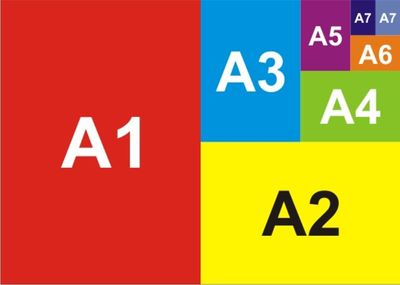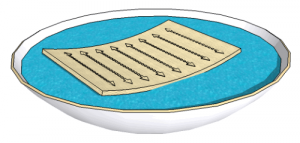Paper and Card: Difference between revisions
From DT Online
m (Added Sections) |
(Added card weights info) |
||
| Line 33: | Line 33: | ||
====[https://en.wikipedia.org/wiki/Paper_density Paper and Card Weight]==== | ====[https://en.wikipedia.org/wiki/Paper_density Paper and Card Weight]==== | ||
The thickness of paper and board is measured in terms of its weight. This is derived by measuring its mass per square metre (g/m²). The measurement is known as Grammage (gms). Ordinary photocopy paper is usually 80gms and card is about | The thickness of paper and board is measured in microns ''(1000 microns = 1 mm)'' but more commonly in terms of its weight. This is derived by measuring its mass per square metre (g/m²). The measurement is known as Grammage ''(gms)''. Ordinary photocopy paper is usually 80gms and thin card is about 200 microns thick and weighs 150gms to 160gsm. This is equivalent to two sheets of ordinary paper and is also known as ''2-sheet'' card. | ||
Other card thicknesses are: | |||
{| | |||
|- | |||
! '''Type of Card''' | |||
! Description | |||
! Equivalent<br />Paper<br />Thickness | |||
! Thickness | |||
! Grammage | |||
|- | |||
| '''Thin Card ''' | |||
| Suitable for use in most photocopiers. | |||
| 2-Sheet | |||
| 200 microns | |||
| 150-160gsm | |||
|- | |||
| '''Flexible Card''' | |||
| Easily folded to make small models | |||
| 3-Sheet | |||
| 230 microns | |||
| 170-180gsm | |||
|- | |||
| '''Medium Card''' | |||
| Suitable for general modelling and making gift cards etc. | |||
| 4 and 6-Sheet | |||
| 280-300 microns<br />350-380microns | |||
| 210-240gsm<br />270-290gsm | |||
|- | |||
| '''Thick Card''' | |||
| Needs cutting with a craft knife and can be used for photography mounts or display boards etc. | |||
| 8, 10 and 12-Sheet | |||
| 500 microns<br />580 microns<br />750 microns | |||
| 385gsm<br />460gsm<br />550-590gsm | |||
|} | |||
The strength of paper is not determined by its thickness but by the types of fibre and additives used in its production. | |||
----- | ----- | ||
<span style="color: blue">'''Activity:''' | <span style="color: blue">'''Activity:''' | ||
Revision as of 19:53, 16 March 2016
Paper is mainly a web of vegetable fibres called cellulose which is extracted from wood pulp. Other plant fibres such as cotton, flax, hemp, bamboo, sugar cane and cereal straw can also be used but wood is the most widely used source. Small amounts of additives in the form of minerals, chemicals or dyes enhance particular properties, such as whiteness or strength.
Board is the industry's name for cardboard and is made from several layers of pulp. Very thick board is made by sticking together sheets of paper or board. This is known as laminating.
Sheet Sizes
The sizes of paper and card commonly used follow the ISO Standard - e.g. A4, A3 etc plus B4, C5 etc. There is also a North America Standard with sizes including letter, legal, ledger, etc.
The most frequently used paper size is A4. A sheet measures 210 by 297 millimetres (8.27in × 11.7in) and a sheet of ordinary copier paper weighs 5 grams. Other common sizes are:
- A5 = 148mm × 210mm
- A3 = 297mm × 420mm
- A2 = 420mm × 594mm
The base A0 size of paper is defined as having an area of 1m² rounded to the nearest millimetre
Note: The ratio of one side of ISO Standard paper to the other is √2 resulting in paper sizes which can be folded in half to create the next size.
Grain
Almost all paper and board has a natural grain which allows the surface to curve and fold more easily in one direction. During paper and board manufacture, most of the fibres line up in the direction of the machine movement. This gives paper and board its grain which produces similiar effects to the grain in wood. Wet paper will expand more across this grain than along it. Strips of paper cut along the grain will be stiffest and those cut across will curl more easily. This should be considered when involved in some aspects of paper engineering - e.g. making a paper spring.
Activity:
If a square of paper is floated on the top of a dish of water, the edges will curl up such that the axis of curl is parallel to the grain direction.
Paper and Card Weight
The thickness of paper and board is measured in microns (1000 microns = 1 mm) but more commonly in terms of its weight. This is derived by measuring its mass per square metre (g/m²). The measurement is known as Grammage (gms). Ordinary photocopy paper is usually 80gms and thin card is about 200 microns thick and weighs 150gms to 160gsm. This is equivalent to two sheets of ordinary paper and is also known as 2-sheet card.
Other card thicknesses are:
| Type of Card | Description | Equivalent Paper Thickness |
Thickness | Grammage |
|---|---|---|---|---|
| Thin Card | Suitable for use in most photocopiers. | 2-Sheet | 200 microns | 150-160gsm |
| Flexible Card | Easily folded to make small models | 3-Sheet | 230 microns | 170-180gsm |
| Medium Card | Suitable for general modelling and making gift cards etc. | 4 and 6-Sheet | 280-300 microns 350-380microns |
210-240gsm 270-290gsm |
| Thick Card | Needs cutting with a craft knife and can be used for photography mounts or display boards etc. | 8, 10 and 12-Sheet | 500 microns 580 microns 750 microns |
385gsm 460gsm 550-590gsm |
The strength of paper is not determined by its thickness but by the types of fibre and additives used in its production.
Activity: Weigh a full pack of copier paper and divide the result by the number of sheets to check the weight of a single sheet.
Types of Paper and Card
| Tissue Paper: | Absorbent lightweight paper extensively used in packaging and for general cleaning purposes. |
| Tracing Paper | Once used extensively to prepare drawings for copying and still useful when copying shapes of parts or protecting plans when using them to locate components for gluing - e.g. during model aircraft construction |
| Copier Paper | General purpose paper, often used in A4 sheets for office work and printing. |
| Cartridge Paper | A thicker gauge of paper with a more porous surface and commonly used for Technical Drawing. |
| Newsprint | A low-cost paper most commonly used to print newspapers but also very suitable for Papier-mâché work |
| Brown Paper | Also known as Kraft Paper, the reverse side of this tough wrapping paper provide a good bite when free-hand sketching |
| Baking Parchment | This provides a non-stick surface capable to withstanding oven temperatures. |
| Sugar Paper | Also known as Construction Paper, this heavier grade, coarse, coloured paper is useful for general larger-scale paper modelling and prototyping |
| Cardboard | A general term used to describe thicker materials - usually in excess of 134 g/m2. In common useage it tends to refer to Card Stock often used for Postcards or Paperboard used in packaging for example. |
| Corrugated Cardboard | Used in heavier cartons and useful also for larger-scale modelling and prototyping. |

